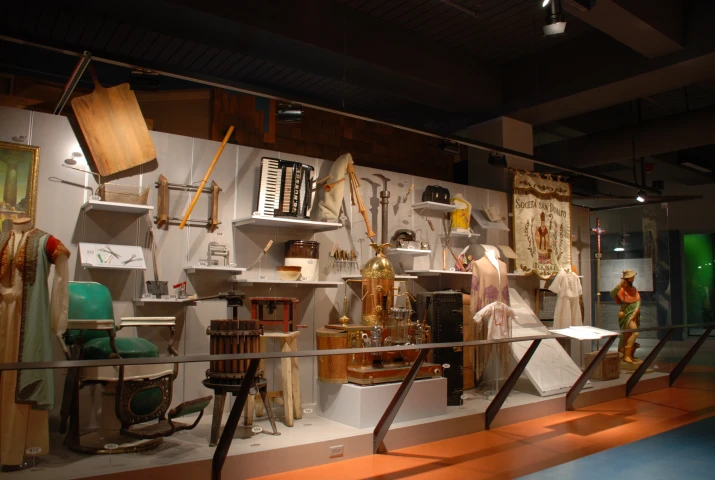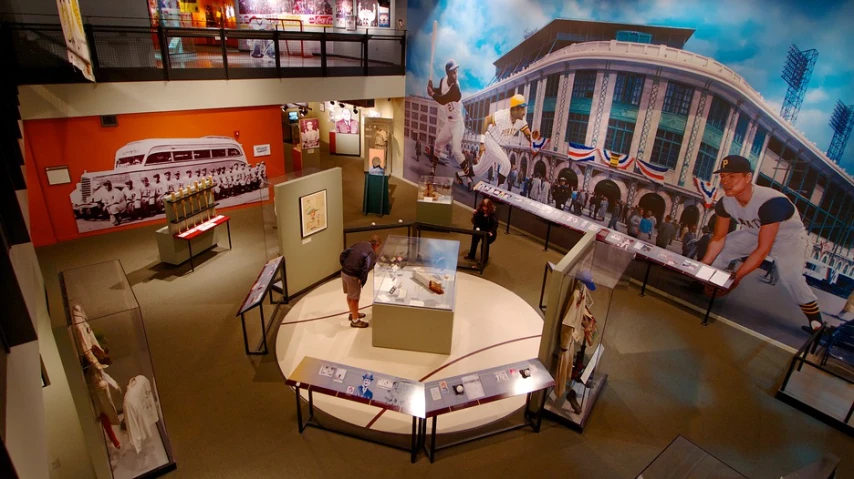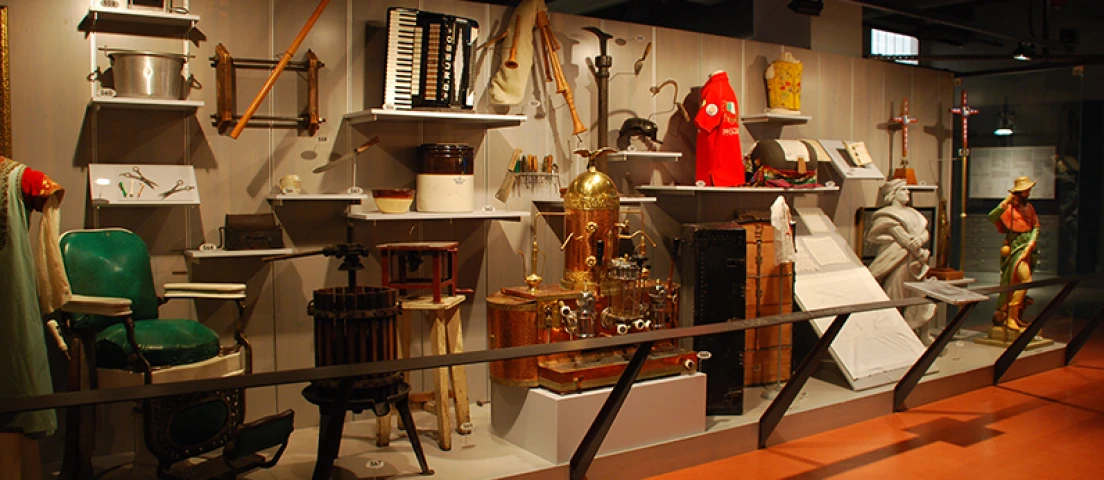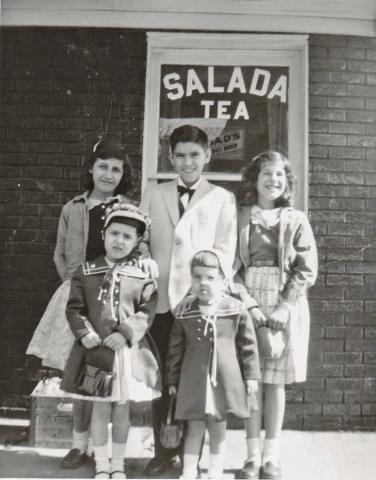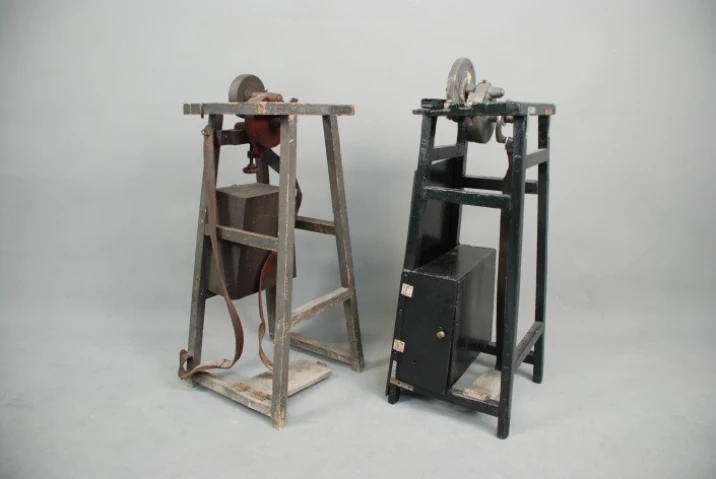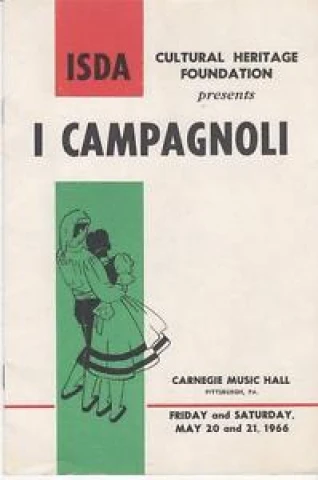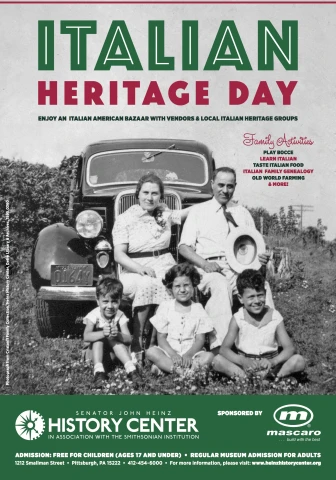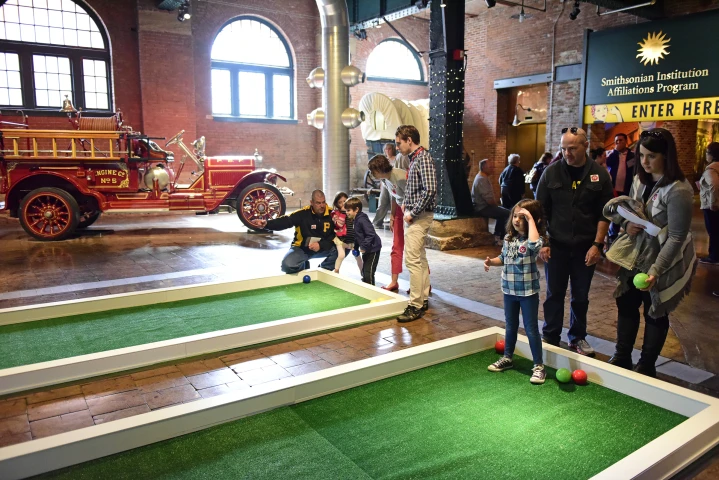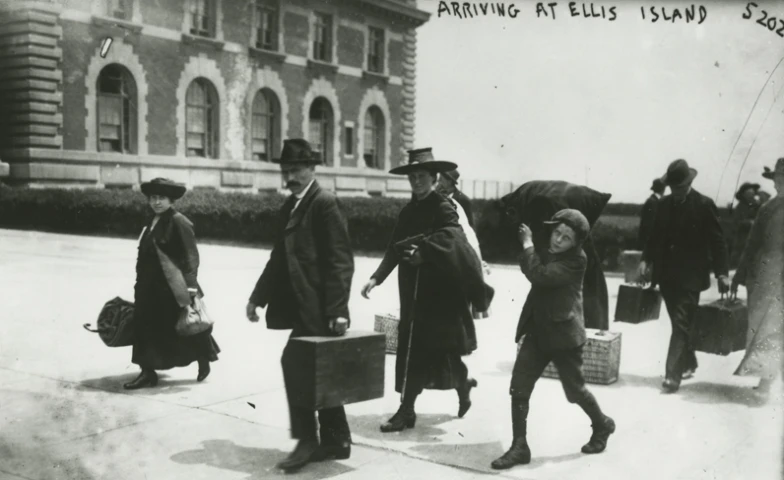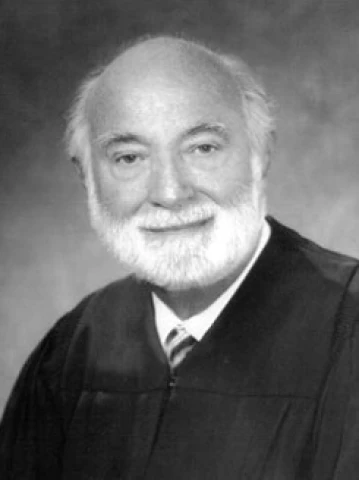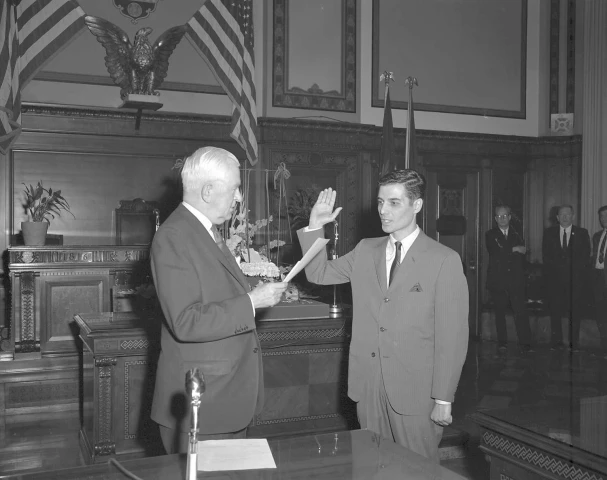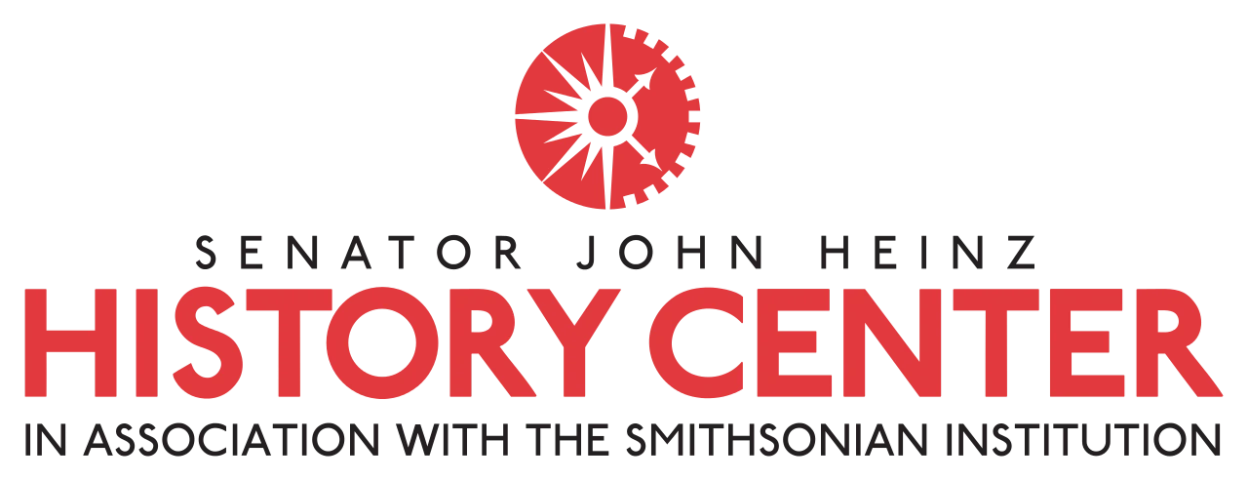Looking for Italian traces all over the 50 States, this time we get back to Pennsylvania, the Keystone State: more precisely to Pittsburgh, Western Pennsylvania.
One of the main concerns that several Italian American friends have told us is that young Italian Americans could feel their bound with their heritage in a different, slighter way. Well, that may be, but today we meet with a young enthusiast Italian American who is very competent about her Italian heritage, the best person to explain to our readers the story of our fellow Italians in Western Pennsylvania. Thanks to Melissa Marinaro for meeting us
Melissa, you are the curator of the Italian American Program at the Senator John Heinz History Center in Pittsburgh, PA. Please tell us something about this program.
The Italian American Program was founded in 1990 and is dedicated to preserving and interpreting the history and culture of Italian Americans in Western Pennsylvania. We do so through exhibitions, educational programs, publications, and community outreach. We began this program at the urging of prominent members of our local Italian American community, who recognized that the history of Italian Americans was deeply embedded within the history of Western Pennsylvania and chose to base the program within the Historical Society of Western Pennsylvania (we operate as the Senator John Heinz History Center today). By having the program as a part of a large institution, it assures that our history is told alongside the other histories from our region and is not separated from general American history.
The program also manages our Italian American Collection, which is one of the largest repositories of Italian American artifacts and archives in the United States, and for over two decades we have documented the role that Italian Americans played in shaping our region's political, economic, religious and culture landscapes.
How does the Italian American Collection document Italian Americans and their legacy in Western Pennsylvania?
Our mission is to document the history and culture of Western Pennsylvania's Italian American community, so that the legacy of our community is preserved for future generations. Our collection consists of three main elements:
We have approximately 800 objects, and that includes textiles, utensils, tools, sculptures, and other three dimensional items.
We have thousands of archival materials in the form of books, photographs, immigration documents, family papers, and records from businesses and fraternal organizations.
We have oral histories from more than three hundred first, second, and third generation Italian Americans.
My main role as the curator of the program is to facilitate the interpretation of the objects in the collection and grow the collection by acquiring new objects. There are a couple of ways for us to acquire new items for the collection. The first is that someone in the community contacts me with something they wish to donate to the collection: I meet with them, I hear their story and learn the significance of the item, and then I take into account our collection at the museum and how this object may connect with it and with the larger story of Italian Americans in Pennsylvania. I also consider how it may help me to explain our history to a museum-going audience that may not be Italian American.
To give you an example... we had a family recently donate a homemade scissor sharpening machine that belonged to their father Antonio Antonucci. Antonio used to peddle his sharpener around the city to offer his services. The machine helps to document this aspect of Antonio's life, but it also allows us to tell a larger story about how the Italian immigrants were entrepreneurs and small business owners. We quickly learned that this object was related to another object already in the collection: two decades prior a different member of the Antonucci family donated another scissor sharpener machine that belonged to Antonio's older brother, Francesco.
Now we have been able to reunite the two machines together in the collection, allowing us to tell the story of the two Antonucci brothers, how they came to the United States, lived, worked, and supported their families.
Very interesting
The second way we grow the collection is that I may hear about something in the community, such as a story or a business, and (then I will pursue to document it) by reaching out to either community members that I already have established relationships, or by making new connections. Sometimes I may send a letter, or make a phone call: at the moment, I am working to document a group called "I Campagnoli". They were a folk music and dance troupe (supported by the Italian Sons and Daughter of America) active from 1964 to 2013 that performed all around the Mid-Atlantic region. I connected with one former member of the group who had some musical instruments and photo albums. Then she helped me connect with another member who had costumes, who helped me connect to another member who had sheet music. The collecting effort began a year ago and it has grown as a chain reaction among the various men and women who were members of I Campagnoli.
How big is the space you have at the History Center?
Most of our collection is in storage, what the museum has on display is about 10% of what is in the entire collection. We do have an area in our fourth floor Special Collections gallery dedicated to the Italian American Collection and there are approximately seventy-five items on display.
The display gives you a good overview of what is in the collection, what topics we have collected about, such as the religious and spiritual life of the Italian Americans, domestic life, skilled and unskilled laborers, Italian American foodways, etc. The three dimensional items that are not on display live in the museum storage with the rest of our artifact collection and all our archival items (papers, photographs, and audio recordings) are housed in the Detre Library & Archives.
What's nice about the archival collection is that it is publicly accessible anytime the library is open. So, if you were a researcher, you could come to our institution to look at, for example, ship tickets or passports or any kind of immigration material in the collection and you would be able to use, handle, and/or photocopy them. It's a wonderful way for us to make the collection available to the public.
We are talking about the papers, not the objects that are 90% in storage, right?
Yes. The objects are not accessible without first making arrangements with our museum staff, but they are still accessible to the public for researcher. For example, we have had university students conduct research for their dissertations by arranging to look at artifacts that are not on display. Because we have nearly 50,000 objects in the entire museum collection, we need to coordinate with more staff in order to make artifacts not on display available.
Over the last five years, we have worked to digitize a lot of content, so if a person is not able to physically come to our building, we have the ability to send photographs of objects or scans of paper material. And, now all of our audio content is also available in a digital format.
On the first Sunday of October, the Center organizes the Italian Heritage Day. What happens during this event?
Italian Heritage Day is an annual program that we started offering three years ago. The main objective of Italian Heritage Day is to offer fun interactive activities for families to learn about Italian American history and culture. All of the activities, which are facilitated by local organizations and museum staff, are designed so that the whole family can work together, such as learn how to play bocce or learn vocabulary in the Italian language, so that when the family leaves our museum, hopefully the younger generation will ask questions to the old generation. Our goal is for children to walk away with questions, like: "When did our family come to America?" or "Who was the first person who came to the Unites States?" or "Why did they leave Italy?" and "Why did they choose to settle in Western Pennsylvania?" The reason we do this is that we think children will perpetuate the Italian culture in our region, and in order to have them do so, we want them to be curious about our culture, and we want to offer them platforms where they can experience the Italian American life.
We also have an Italian American bazar at Italian Heritage Day, where we have many different local organizations present that offer programming related to Italian Heritage. We give them space to come together and set up information tables. The public can find out about which groups focus on Italian genealogy, which teach the Italian language, or which celebrate different regions such as Calabria and Tuscany. We want people to know that through these organizations, you can celebrate your Italian heritage in Western Pennsylvania all year round.
So what's the story of the Italian emigration to Western Pennsylvania?
Italian emigration to Western Pennsylvania looks very similar to Italian emigration to other American cities. Italian men came to our region mainly to work as laborers in the mines and in the mills. The first wave of migration came at the end of the nineteenth and at the beginning of twentieth century; this is where we can see the largest numbers of Italian immigrants coming in. They were working the jobs that Americans didn't want to do, and because of the lack of labor laws and unions, these jobs were dangerous and unregulated. As their number grew, these male migrants would send money home for their families in Italy or they would return to their country to find a wife and bring her back to Western Pennsylvania, the city of Pittsburgh and its surrounding Counties.
What happens when you start having a large number of Italians is that they begin to establish institutions for their communities. Italians were typically not welcome at Irish or German Catholic parishes during this period, so they began establishing their own churches where they could celebrate festas and venerate their Saints in the way that they were accustomed to in Italy. The Irish and the Germans didn't quite understand the Italian brand of Catholicism, seeing them as being a little bit too superstitious.
Besides building churches, they also established mutual beneficial societies and lodges, which were support systems that acted as both insurance agencies that could protect families and a social center for the community, for people to gather and talk in their own language.
Our first Little Italy in Pittsburgh was Downtown, in the area where the Cultural District is today, and that formed in the late 1880's, early 1890's. At the turn of the century many Italians were settling in the Lower Hill District, which was a neighborhood with Italian immigrants as well as Greek, Syrian, and Jewish immigrants, and African Americans. A couple other well-known Little Italies in our community were Larimer Avenue in East Liberty, which thrived in the 1920's, 1930's and 1940's; and the neighborhood of Bloomfield, which developed its Italian identity in the 1940's, 50's and 60's and is still considered Pittsburgh's Little Italy.
Because of language barriers with many immigrants speaking their own distinct dialect, you can see a pattern of settlements in our region. You will notice that people from specific regions tended to settle in the same neighborhoods because of their ability (or inability) to communicate. The Sicilians settled in the North Side of Pittsburgh, and they mostly worked in the wholesale produce business, whereas the Toscani first came to the Hill District and then relocated down to the South Side, living in the neighborhoods of Knoxville, Beechview, and Beltzhoover. They typically worked in the restaurant industry.
So, if you look through our collection, you are able to pick up on these patterns of settlement: this has allowed us to create a map of the region where we can see not just the regional immigration, but even from specific Italian towns. For example, we know that the area of Panther Hollow, which is in the neighborhood of South Oakland, was home to mostly Italian immigrants from Pizzoferrato and Gamberale, two towns in the province of Chieti in Abruzzo. Around Western Pennsylvania, you will find families that are still living in the same neighborhoods where their grandparents or parents immigrated to.
Are there personalities or facts that have had or still have a particular importance in describing Italy in Western Pennsylvania?
This is not an easy question because everything and everyone is important: I think that a lot people are surprised to learn what a big presence Italian Americans have in Western Pennsylvania, as we tend to get overshadowed by Philadelphia.
Education is something that our community has valued very much, and I think a lot of it has to do with the fact that people migrating from Southern Italy in the era when they came often didn't have access to education. Education was strongly emphasized within the families: the parents pushed their children not just to go to high school but also to college, many Italian Americans in our community have advanced degrees and I think this has resulted in members of our community being in prominent positions today.
We have some people in political positions here in Western Pennsylvania that broke new ground for Italian Americans to be in more positions of power. We have Judge Ruggero J. Aldisert and former mayor of Pittsburgh Mayor Richard Caliguiri, who were two early Italian Americans in their line of work. They definitely broke down barriers as far as Italian Americans reaching new heights in their fields, and I feel that this paved the way for some of our current political leaders. Our current mayor in Pittsburgh is Bill Peduto, who is of Italian American descent, as well as two of our State Senators, Wayne Fontana and Jay Costa.
Are there many new Italians, those who just recently moved to the US, in Pittsburgh?
There are some. They are not coming in the numbers that they did at the beginning of the XX century or in the post-war period, but we do have a third wave of Italian immigrants that now live in our region. Many of them are part of the European brain drain of the last three decades, and they've come to Western Pennsylvania, Ohio, and West Virginia to work in the University system. In Pittsburgh specifically, many of them are working in the medical field, one of the largest industries in our city. I was recently talking with one of my colleagues, and she estimates that there are approximately one thousand Italian nationals living in Pittsburgh today. It is hard at this point to know if they will remain in our region. A few will decide to become citizens and make Pittsburgh their permanent home, but many are stationed here on assignments under work visas. It's hard to tell how many will choose to remain in Pittsburgh.


